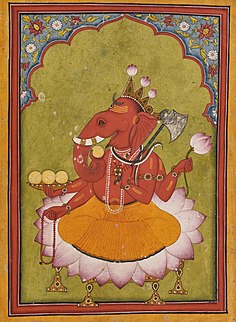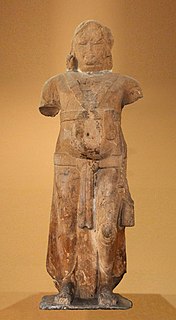 W
WIn Jainism, Ambika or Ambika Devi is the Yakṣi "dedicated attendant deity" or Śāsana Devī "protector goddess" of the 22nd Tirthankara, Neminatha. She is also known as Ambai, Amba, Kushmandini and Amra Kushmandini. She is often shown with one or more children and often under a tree. She is frequently represented as a pair with a small Tirthankar image on the top. The name ambika literally means mother, hence she is Mother Goddess. The name is also common epithet to with Hindu Goddess Parvati.
 W
WIn Jain cosmology, Chakeshvari or Apraticakra is the guardian goddess or Yakshini of Rishabhanatha. She is the tutelary deity of the Sarawagi Jain community.
 W
WDharanendra is the Yaksha of Parshvanatha, twenty-third Tirthankara in Jainism. He enjoys an independent religious life and is very popular amongst Jains. According to the Digambara tradition, when Lord Parshvanatha was a prince, he saved two snakes that had been trapped in a log in an Kamath’s fire. Later, these snakes were reborn as Dharanendra, the lord of the underworld Naga Kingdom, and Padmavati. They, then sheltered Parshvanatha when he was harassed by Meghalin. Śvētāmbara tradition, however, does not list Padmavati among the main queens of Dharanendra.
 W
WGanesha, or Ganesh, also known as Ganapati and Vinayaka, is one of the best-known and most worshipped deities in the Hindu pantheon. His image is found throughout India, Nepal, Sri Lanka, Thailand, Bali (Indonesia) and Bangladesh and in countries with large ethnic Indian populations including Fiji, Mauritius and Trinidad and Tobago. Hindu denominations worship him regardless of affiliations. Devotion to Ganesha is widely diffused and extends to Jains and Buddhists.
Ghantakarna Mahavira is one of the fifty-two viras of Svetambara Jainism. He is chiefly associated with Tapa Gaccha, a monastic lineage. He was a deity of the Jain tantrik tradition. There is a shrine dedicated to him at the Mahudi Jain Temple established by Buddhisagar Suri, a Jain monk, in nineteenth century. It is one of the popular Jain pilgrimage centres of India.
 W
WIn Jain cosmology, Gomukha is the guardian god or Yaksha of Rishabhanatha, the first Tirthankara.
 W
WIsakki or Isakkai is a Hindu Goddess. Worshiping her remains popular among Hindus in the southern Indian districts of Tamil Nadu, specifically the Kanyakumari, Tirunelveli and Salem districts. She is generally considered to be one of the 'village deities' and is commonly referred to as "Isakki Amman". Village deities are believed to act as guardian spirits.
 W
WJwala Ji is a Hindu Goddess. Alternative spelling and names for Jwala Ji include Jawala Ji, Jwala Devi and Jwalamukhi Ji. The physical manifestation of Jwala Ji is always a set of eternal flames, and the term Jwala means flame in Sanskrit and Ji is an honorific used in the Indian subcontinent.
 W
WJwalamalini or Jvālāmālinī( Sanskrit: ज्वालामालिनी,Kannada: ಜ್ವಾಲಾಮಾಲಿನೀ) is the Yakshini of the Eighth Tirthankara, Shri Bhagwan Chandraprabhu in Jainism and was one of the most widely invoked Yakshinis in Karnataka during the early medieval period.
 W
WKubera also known as Kuvera, Kuber or Kuberan, is the Lord of Wealth and the god-king of the semi-divine Yakshas in Hindu culture. He is regarded as the regent of the North (Dik-pala), and a protector of the world (Lokapala). His many epithets extol him as the overlord of numerous semi-divine species and the owner of the treasures of the world. Kubera is often depicted with a plump body, adorned with jewels, and carrying a money-pot and a club.
 W
WManibhadra is one of the major yakshas. He was a popular deity in ancient India.
 W
WNaigamesha, also known as Harinegameshi, is a goat-headed or deer-headed deity, associated with children. He also appears in Jain as well as Hindu traditions, associated with the war-god Kartikeya and childbirth.
 W
WPadmāvatī is the protective goddess or śāsana devī (शासनदेवी) of Pārśvanātha, the twenty-third Jain tīrthāṅkara, complimenting Parshwa yaksha, the shasan deva. She is a yakshi of Parshwanatha.